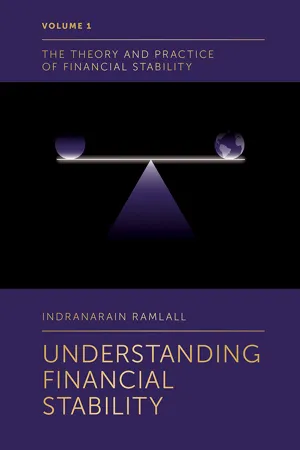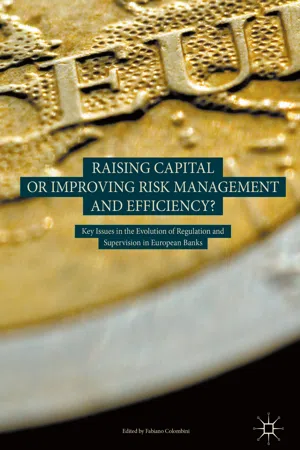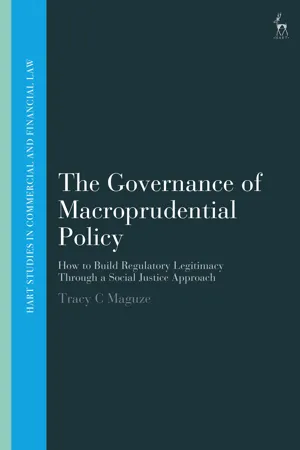Economics
Financial Supervision
Financial supervision refers to the regulatory oversight and monitoring of financial institutions and markets to ensure their stability, integrity, and compliance with laws and regulations. It involves the supervision of activities such as lending, investment, and risk management to safeguard the interests of consumers and maintain the overall health of the financial system.
Written by Perlego with AI-assistance
Related key terms
Related key terms
1 of 4
Related key terms
1 of 3
7 Key excerpts on "Financial Supervision"
- eBook - ePub
- Indranarain Ramlall(Author)
- 2018(Publication Date)
- Emerald Publishing Limited(Publisher)
More engaging FSRs contain a complete database or tables of data which are found in the appendix section. Some FSRs are even being proactive by pinpointing risks likely to manifest for the forthcoming months.Whether an almost cashless society like the Swedish1 economy or not, a financial system can be defined as the composition of financial markets, financial institutions, financial instruments and rules and regulations (legal processes), financial architectures and economic agents. Financial regulation pertains to a set of rules and principles which contribute towards a stable and efficient financial system. Rules and regulations are mainly underpinned through legislations or acts such as central bank Act, Banking Act, Insurance Act and Microfinance Act, amongst others. There are different forms of financial markets such as capital markets (long term), money markets (short term), commodity markets, derivatives markets and foreign exchange markets. Financial institutions comprise of banks, insurance companies, pension funds, securities and investment companies. Financial instruments consist of shares, bonds, savings accounts, convertible debt, commercial papers and certificate of deposits, amongst others Economic agents consist of different economic units such as households, corporates, banks, non-banking institutions and the government. Interactions among different economic agents are particularly important as stated by Filardo (2008), ‘The more difficult angles to grapple with, however, are the interactions amongst the various players at the centre of financial instabilities’.A three-pronged approach of financial stability for financial markets is explained as follows:- ability to allocate resources efficiently;
- ability to manage risks; and
- ability to absorb shocks.
2.2. Definition of Financial Stability
Financial stability can be defined as the smooth operation of all segments of the financial system. However, as at date, there prevails no universally valid definition of financial stability. Financial stability constitutes a broad concept which involves both preventive and remedial actions. Financial stability constitutes a public good which involves all market players in an economy. The financial system has brought increasing challenge to financial stability maintenance as the financial system shifted from a bank-based system to a more market-based system. Any financial stability assessment operates under a continuum: that is, financial stability, at one end, and financial instability, at the other end, in spite of the fact that it is difficult to define and even more difficult to measure financial stability. A standard and narrow definition of financial stability pertains to the notion that the financial system operates without being adversely affected by financial crises. A broader definition of financial stability implies that the financial system (financial markets, financial architecture, economic agents, financial institutions, financial instruments and rules and regulations) operate smoothly. The burgeoning interest of central banks in financial stability can be demonstrated by the publication of FSRs, which have grown in number, size and quality but less in being proactive, aligned to the notion that financial sector stability can be defined as the ability of the financial system to withstand both internal and external shocks. - eBook - ePub
Investment and Portfolio Management
A Practical Introduction
- Ian Pagdin, Michelle Hardy(Authors)
- 2017(Publication Date)
- Kogan Page(Publisher)
Authorization of companies or individuals will involve an element of thorough research into the background and history and may be dependent upon reaching a minimum level of qualifications or prescribed standards of conduct. The precise method and intensity of monitoring will depend upon the level of risk posed by the company or individual, the perceived likelihood of breaching the rules/regulations, the potential consequences of a breach in the rules/regulations and the supervising agency’s resources. Any enforcement procedures may occur for a variety of reasons including the supervisor’s monitoring activities, or a complaint by a customer or another market participant. Enforcement procedures would usually involve some form of investigation to determine exactly what has occurred, the root cause and if further action or sanction is required. The supervising agency may employ the use of enforcement officers with powers to investigate and to gather information. It may be that there is an agency which is appointed with the responsibility for monitoring compliance and the identification of suspected rule breaking, but a separate agency has the responsibility to determine if the suspicion is proven and if so, to apply an appropriate penalty, sanction or impose compensation.Regulation in financial markets
It is generally accepted that the operations of the financial markets are pivotal in the development of any economy and the financial sector is the mechanism which facilitates the exchange of goods and services in the economy and to transfer the savings of an economy into investments. A sound, efficient and well-managed financial sector will accomplish this process, encouraging more savings and therefore more investment in the process. This should result in faster economic growth, improved levels of income and therefore the end result should be the improvement of well-being domestically, within the economy. Strong and efficient domestic financial markets may also be of significant benefit to global growth in the form of investment capital movement from wealthier, more developed economies, to emerging and developing economies.It has been mentioned earlier in the chapter that one of the reasons for robust regulatory regimes being so important is the issue that information asymmetry exists, within the finance sector, between the sellers of financial products and the buyers. Generally, most markets work well when there is a high frequency of repeat purchases of a given product, because in these market circumstances, it is quite straightforward for an individual to determine the inherent quality of the product. It is also easy for the individual to switch away from a poor quality product to a product of better quality and not to make the same error in the future. - eBook - ePub
Raising Capital or Improving Risk Management and Efficiency?
Key Issues in the Evolution of Regulation and Supervision in European Banks
- Fabiano Colombini, Fabiano Colombini(Authors)
- 2018(Publication Date)
- Palgrave Macmillan(Publisher)
© The Author(s) 2018Begin AbstractFabiano Colombini (ed.)Raising Capital or Improving Risk Management and Efficiency? https://doi.org/10.1007/978-3-319-71749-4_1010. Banking Regulation and Supervision in the USA
End AbstractPaola Ferretti1(1) Department of Economics and Management, University of Pisa, Pisa, ItalyPaola Ferretti10.1 Introduction
Regulation and supervision in the USA, similarly to other contexts, constitute two distinct yet complementary activities, without a strict legal separation.Regulation defines the framework of rules within which financial intermediaries can carry out their business. Once the rules have been defined, supervision guarantees that they will be respected: the supervision provides the necessary assurance that financial institutions will operate in a safe and sound manner by monitoring , inspecting, and examining them.Overall, financial regulation aims to protect borrowers and investors who are participating in financial markets and to mitigate financial instability. US banking regulation is traditionally focused on prudence.This chapter aims to outline the distinctive elements of banking regulation and supervision in the USA, highlighting the structure of the Federal Reserve System , its main areas of intervention, and the tools utilised to achieve the above-stated objectives.10.2 The Federal Reserve System, Regulation, and Supervision
The Federal Reserve System supervises and regulates a wide range of financial institutions and activities. The Federal Reserve works in conjunction with other federal and state authorities (e.g. the Office of the Comptroller of the Currency, the Federal Deposit - eBook - ePub
- International Monetary Fund(Author)
- 2005(Publication Date)
- INTERNATIONAL MONETARY FUND(Publisher)
Chapter 5 Evaluating Financial Sector Supervision: Banking, Insurance, and Securities MarketsThis chapter looks at the legal, institutional, and policy framework needed to ensure effectiveness of financial sector supervision. It focuses on banking, insurance, and securities markets. Effective supervision, however, depends on a legal and institutional environment that provides the necessary preconditions. Those preconditions include the following:- The provision and consistent enforcement of business laws—including corporate, bankruptcy, contract, consumer protection, and private property laws—and a mechanism for fair resolution of disputes
- Good corporate governance, including adoption of sound accounting, auditing, and transparency procedures that carry wide international acceptance and that promote market discipline
- Appropriate systemic liquidity arrangements, including secure and efficient payment clearing systems that enable adequate control of risks and efficient management of liquidity
- Adequate ways to minimize systemic risk, including appropriate levels of systemic protection or safety nets and efficient procedures for handling problem institutions
The preconditions complement the legal and institutional framework governing the specific sectors of the financial system (banks, nonbank financial institutions, rural and microfinance entities, securities markets, and insurance providers) and their supervision, which is discussed in section 5.1 . The broader legal framework governing the preconditions is covered in chapter 9 . Section 5.2 in this chapter focuses specifically on the legal and institutional aspects of financial sector safety nets, one of the key preconditions affecting governance and stability of banking institutions. The scope and content of international standards on financial sector supervision in banking, insurance, and securities markets and the issues in assessing compliance with these standards are taken up in detail in the subsequent sections of this chapter (sections 5.3 –5.5 - International Monetary Fund(Author)
- 1991(Publication Date)
- INTERNATIONAL MONETARY FUND(Publisher)
III Recent Developments in the Regulation and Supervision of Financial Markets
The trends in financial flows and asset prices discussed in the preceding section occurred in the context of a continuing process of financial market internationalization and integration. This process intensified during the 1980s and has contributed to more efficient market mechanisms for the mobilization and allocation of savings, both nationally and internationally. Nevertheless, the resulting intensification of competition and pressure on profitability may, at the same time, undermine the viability of certain established institutions and market structures. Similarly, the increasing ease with which the location of financial activities may be shifted from one segment or jurisdiction to another may have adverse systemic risk implications. While there have been some instances of localized strains on financial institutions and markets, regulatory and supervisory systems have generally succeeded in containing disruptions.The focus of this section is on international coordination and cooperation efforts in the regulation and supervision of financial markets. A central element of such regulatory and supervisory responses—developed over the last few years at the international level—has been the formulation of policies to ensure that the capital underpinning the activities of financial institutions is adequate. The risk-weighted capital adequacy requirements of the Basle Committee on Banking Supervision, analogous EC directives in this area, and related steps to extend similar treatment to nonbank securities firms provide the principal examples of such responses. To date, international policy coordination in the capital adequacy area has focused primarily on the appropriateness of capital relative to credit risk. But with increasingly active markets in a wide range of financial instruments and the blurring of institutional distinctions between various financial activities—a tendency that is likely to intensify as regulatory barriers are further eroded—increased attention has been devoted to improving the coverage of capital adequacy for market risks- eBook - ePub
The Governance of Macroprudential Policy
How to Build Regulatory Legitimacy Through a Social Justice Approach
- Tracy C Maguze(Author)
- 2024(Publication Date)
- Hart Publishing(Publisher)
3 The Objectives and Conduct of Modern Financial RegulationThe financial sector has permeated every facet of modern existence and is now part of the very fabric of society; its attraction goes beyond the reduction of costs, resource mobilisation and risk management. Financial systems that are more effective at allocation of resources to their most productive use can have a profound impact on productivity and economic development and, in turn, social justice. This essential role of financial systems has been forcefully brought to the fore by the body of research showing the link between finance and economic growth and the succession of financial crises over the last two decades.1The link between a developed financial sector and economic growth has been the subject of numerous studies since the seminal work of King and Levine.2 The research has shown that a broad, deep and liquid financial system is a key determinant of economic and social development;3 can be used to manage the risk of all consumers of financial products, whether they shop on Wall Street or at Wal-Mart;4 and can aid the poorest 40 per cent of households to transact more efficiently and safely.5The next sections of this chapter will go through how the financial system contributes to allocative efficiency which was identified as the value motivating acceptance of economic regulators’ authority; why financial markets fail and the effects of such failure; and how the state intervenes to correct the market failures in order to restore efficiency. While there have been a number of market failures and consequently effects, this book will focus on failures in the form of negative externalities and the resultant financial instability. - eBook - ePub
Access to Finance
Microfinance Innovations in the People's Republic of China
- (Author)
- 2015(Publication Date)
- Asian Development Bank(Publisher)
Rural Financial Regulation and SupervisionIntroduction
Rural financial regulation and supervision entails monitoring the liquidity, risk and profitability, capital adequacy, and operational compliance of RFIs to ease and defuse financial risks and guarantee the stability of the rural financial system. It covers the following three main stages in the operation of RFIs: (i) market entry (regulation of new entrants with respect to minimum capital requirements, experience and qualifications of bank executives, operational scope, and necessary service facilities and equipment); (ii) operation (supervision of the operation, scope of business, and risks of existing RFIs); and (iii) market exit (termination of dysfunctional RFIs).Rural financial regulation and supervision implements three types of measures corresponding to these three stages: (i) ex-ante (preventive), (ii) during the event (rescue), and (iii) ex-post (remedial). Ex-ante regulatory and supervisory measures, used during market entry, consist of requirements related to licensing, capital adequacy, repayment capacity, operational scope, credit concentration and large loan exposure, management, and auditing. Their main purpose is to prevent or restrict the operational risks of banks. Supervisory measures during the event pertain to the operations of RFIs and restrictions on their scope of business. For instance, RFIs are of three possible types: savings-only institutions, lending-only institutions, and institutions permitted to engage in both savings and lending operations. Ex-post supervision, involving mainly deposit insurance, is a final defense to protect depositors and to stabilize the financial system.Sustained economic growth and integrated development in the urban and rural areas of the PRC have led to significant changes in the objectives of rural finance policy, in market demand, and in the types of institutions. Regarding changes in policy objectives, the central government launched a new round of rural financial reforms in 2002 and 2003, aimed at building a multilayered, inclusive, and sustainable rural financial system. As far as changes in market demand are concerned, demand for microcredit from rural households for farm production, particularly for seeds and fertilizers in traditional agriculture, has been in decline. In contrast, demand for larger loans for rural structural adjustment, such as loans for large-scale livestock production, cash crops, and agricultural processing, is on the rise (PBC Zhangjiajie Branch 2005
Index pages curate the most relevant extracts from our library of academic textbooks. They’ve been created using an in-house natural language model (NLM), each adding context and meaning to key research topics.
Explore more topic indexes
Explore more topic indexes
1 of 6
Explore more topic indexes
1 of 4






